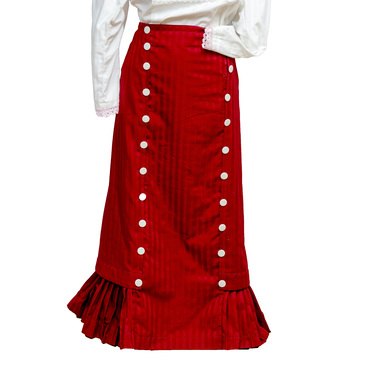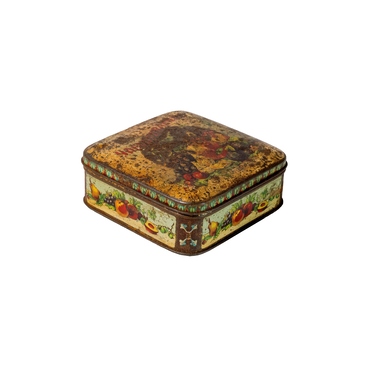A confectionery box from the collection of Nizhnevartovsk Museum of Local History was made at the beginning of the 20th century. The tin container is of regular hexagonal form. The lid is attached to a tin container with a hinged metal loop. All its sides have the same blue pattern depicted against a white background. It shows a lush flower in a flowerpot surrounded by stems and leaves. The picture depicted on the top part of the lid differs from the others. It shows a large flower rosette with curved stems. The inner part of the box and the lid are covered with a thin zinc layer to prevent the box from rust. Over time, the covering has darkened.
There is still a stamp on the inner part of the lid. The inscription reads: “S. Siou and Co. Biscuit Factory. Moscow”. This means that the box was made for a confectionery, belonged to the Siou family, who were French entrepreneurs. Their brand shops were opened in Moscow, St. Petersburg, Kyiv, and Warsaw. After the Russian revolution, the Siou company became state property. Later it was transformed into the confectionery factory “Bolshevik”.
Confectionery tin boxes became popular at the end of the 20th century. They were used to store and transport biscuits, sweets, marmalade, and cakes. Tin boxes did not let desserts be broken or crumbled. Moreover, it could not be pressed. Thanks to this, sweets also stayed fresh longer. When a tin box was emptied, people, as a rule, did not throw the boxes away. They were used to store small things: buttons, threads, jewelry.
The outsides of such boxes were decorated with ornaments or several plot pictures. Famous artists were invited for this purpose. For example, a renowned illustrator Ivan Bilibin decorated the confectionery boxes. Aside from the pictures, there were advertising labels on the boxes which helped attract the buyers’ attention. For the same purpose, the owners of candy shops ordered series and sets of packages. Separate illustrations on a few packages of candy could be combined to reveal a whole picture or they could be united by a theme.
The first confectionery tin boxes were hand-painted. Later, the metallochromy method, or chromolithography, appeared — transferring of an image from a special plate right to the surface of the box.
There is still a stamp on the inner part of the lid. The inscription reads: “S. Siou and Co. Biscuit Factory. Moscow”. This means that the box was made for a confectionery, belonged to the Siou family, who were French entrepreneurs. Their brand shops were opened in Moscow, St. Petersburg, Kyiv, and Warsaw. After the Russian revolution, the Siou company became state property. Later it was transformed into the confectionery factory “Bolshevik”.
Confectionery tin boxes became popular at the end of the 20th century. They were used to store and transport biscuits, sweets, marmalade, and cakes. Tin boxes did not let desserts be broken or crumbled. Moreover, it could not be pressed. Thanks to this, sweets also stayed fresh longer. When a tin box was emptied, people, as a rule, did not throw the boxes away. They were used to store small things: buttons, threads, jewelry.
The outsides of such boxes were decorated with ornaments or several plot pictures. Famous artists were invited for this purpose. For example, a renowned illustrator Ivan Bilibin decorated the confectionery boxes. Aside from the pictures, there were advertising labels on the boxes which helped attract the buyers’ attention. For the same purpose, the owners of candy shops ordered series and sets of packages. Separate illustrations on a few packages of candy could be combined to reveal a whole picture or they could be united by a theme.
The first confectionery tin boxes were hand-painted. Later, the metallochromy method, or chromolithography, appeared — transferring of an image from a special plate right to the surface of the box.



